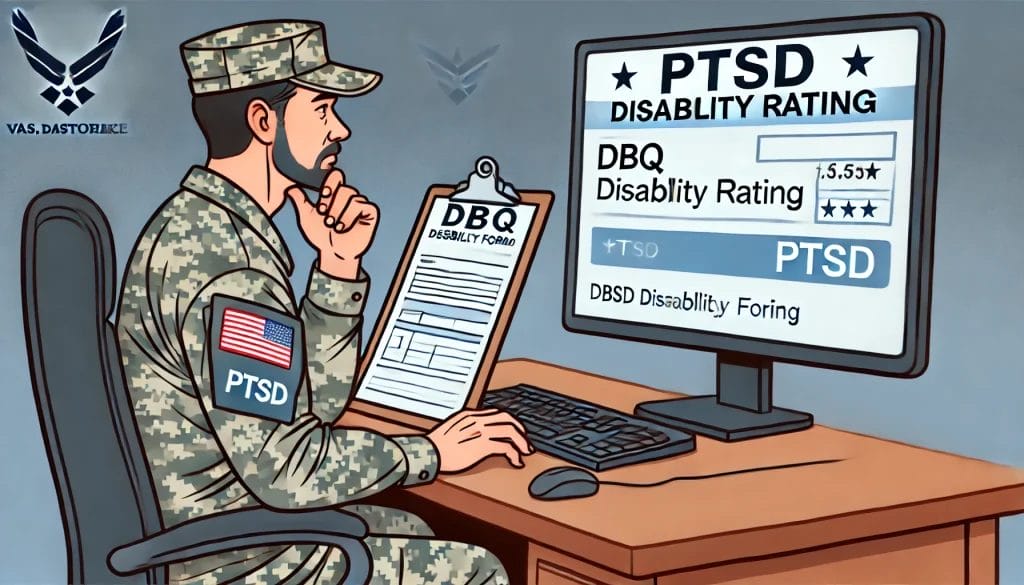Veterans suffering from Post-Traumatic Stress Disorder (PTSD) may be eligible for VA disability compensation.
To determine the severity of PTSD and assign a disability rating, the Disability Benefits Questionnaire (DBQ) is a critical document. This guide will explore how the PTSD DBQ works, the criteria for different PTSD ratings, and how veterans can file for increased compensation or a 100% rating for PTSD.
What is a PTSD DBQ?
The PTSD Disability Benefits Questionnaire (DBQ) is a form that provides the VA with essential information about a veteran’s PTSD symptoms, diagnosis, and how the condition affects their daily life. It is completed by a licensed healthcare provider, such as a psychologist or psychiatrist, who evaluates the severity of PTSD based on established VA criteria.
The DBQ for PTSD allows the veteran’s healthcare provider to detail the frequency, severity, and impact of PTSD symptoms. This helps the VA assign a disability rating based on how PTSD affects the veteran’s ability to function and work.
For more details on the PTSD DBQ, you can review the VA’s official PTSD Review form: PTSD DBQ PDF.
AI Powered Chatbot for VA Disability Claims
Learn more about the VA Disability process and get help with our VA Disability Claim Chatbot programmed and trained by AI

VA Disability Ratings for PTSD
The VA disability rating for PTSD is based on how the condition affects your occupational and social functioning. The ratings range from 0% to 100%, depending on the severity of symptoms and their impact on daily life. Here’s how the VA assigns ratings for PTSD:
0% PTSD Rating
- PTSD symptoms are present but do not interfere with daily functioning or require continuous medication.
10% PTSD Rating
- Mild symptoms that may decrease work efficiency during periods of stress, but generally, the veteran can manage normal activities.
30% PTSD Rating
- Occasional decrease in work performance and intermittent periods of inability to perform daily tasks due to symptoms like anxiety, depression, or mild memory loss.
50% PTSD Rating
- Reduced reliability and productivity due to symptoms such as panic attacks more than once a week, impaired judgment, and difficulty maintaining work and social relationships.
70% PTSD Rating
- Deficiencies in most areas of life (work, school, family) due to symptoms like suicidal ideation, obsessional rituals, impaired impulse control, or near-continuous panic or depression affecting the ability to function independently.
100% PTSD Rating
- Total occupational and social impairment due to severe symptoms like persistent delusions, disorientation to time or place, or memory loss for names of close relatives or one’s own occupation.
For more details on VA PTSD disability rates, check out the VA’s official compensation rates: VA Compensation Rates.
How the PTSD DBQ is Used for Disability Ratings
The PTSD DBQ is essential because it allows your healthcare provider to clearly describe how PTSD affects your life. The VA uses this document to determine your rating based on the severity of your symptoms. The more detailed and accurate the DBQ, the more likely you are to receive the proper rating for your condition.
PTSD Rating Criteria That the VA Uses
The VA follows the General Rating Formula for Mental Disorders, which is found in 38 CFR § 4.130. This formula assigns ratings based on symptoms such as:
- Depression or anxiety
- Flashbacks or nightmares
- Irritability or aggression
- Memory issues
- Difficulty concentrating
The VA considers both the frequency and severity of these symptoms when assigning a disability rating for PTSD. For veterans with severe symptoms that interfere with their ability to maintain employment or relationships, higher ratings (70% or 100%) may be assigned.
How to File a Claim for PTSD Using the DBQ
Filing a claim for PTSD involves several steps, but the DBQ is an essential part of the process. Here’s how to use it:
- Get the DBQ Completed: Have your healthcare provider complete the PTSD DBQ based on your symptoms. Be sure to provide them with any relevant medical records or information about your service-related trauma.
- Submit Medical Records: Along with the DBQ, submit your medical records that show ongoing treatment or diagnoses related to PTSD. This will help strengthen your claim.
- File VA Form 21-526EZ: Use this form to file your disability claim. The form can be submitted through the VA eBenefits portal or mailed with the help of a Veterans Service Officer (VSO).
- Attend a C&P Exam: The VA may schedule a Compensation and Pension (C&P) exam to further evaluate your PTSD symptoms. Be open about the severity of your condition during this exam.
For more on how to file a claim, visit the VA PTSD Eligibility page: VA PTSD Eligibility.

Increasing Your PTSD Disability Rating with a DBQ
If your PTSD symptoms worsen over time, you can file for an increased rating. The DBQ for PTSD Increase should be completed by your healthcare provider and include updated information about your symptoms. Be sure to document:
- How frequently your symptoms occur
- How your condition has worsened
- Any additional treatments or medications you’ve been prescribed
The VA will use this updated DBQ to determine whether you qualify for a higher PTSD rating. For veterans whose symptoms have worsened significantly, the VA may increase the rating to 100% if total occupational and social impairment is proven.
Its also important to understand that there are secondary conditions to PTSD that you may qualify for as well such as IBS Secondary to PTSD.
PTSD DBQ for MST
For veterans who suffer from PTSD as a result of Military Sexual Trauma (MST), the process is similar. The DBQ for PTSD MST will address symptoms specifically related to the trauma. Veterans should submit additional evidence, such as medical records, therapy records, or statements from healthcare providers, to support their claim.
For more information, check out this detailed guide on PTSD VA Ratings: Understanding PTSD VA Rating.
